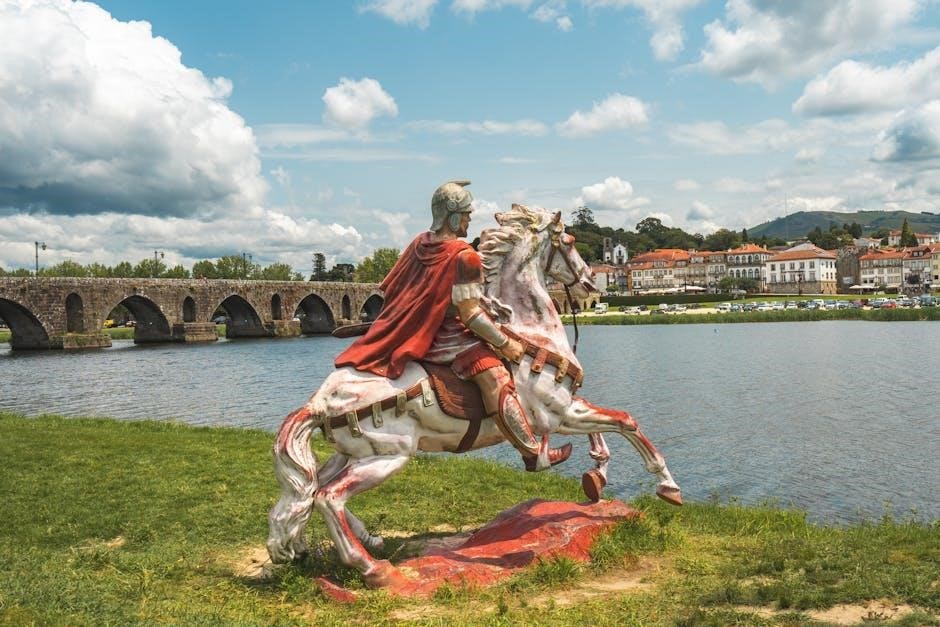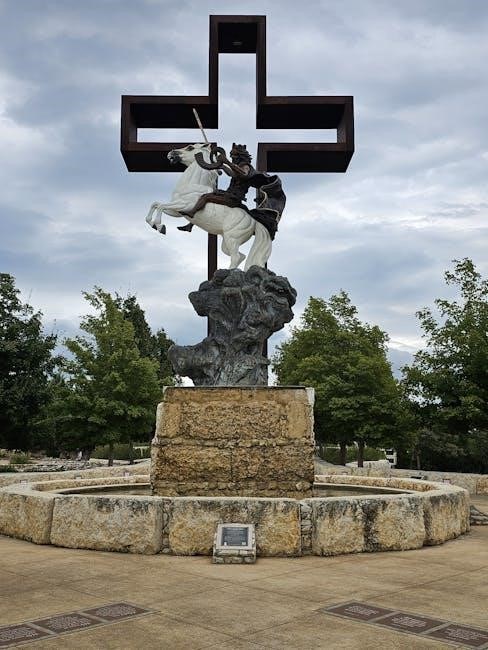Sir Gawain and the Green Knight, translated by Simon Armitage, is a timeless Arthurian tale of chivalry, morality, and enchantment. Armitage’s rendering revitalizes the medieval poem, blending accessibility with poetic richness, offering readers a fresh encounter with a classic narrative of honor, temptation, and the supernatural.
Background of the Poem
Sir Gawain and the Green Knight is a 14th-century chivalric romance written in Middle English. Attributed to the Pearl Poet, its authorship remains anonymous. The narrative combines chivalry, morality, and supernatural elements, set in King Arthur’s Camelot. The poem survives in a single manuscript, highlighting its rarity and historical significance. Its themes of honor and temptation resonate deeply, influencing Arthurian literature. Rediscovered in the 19th century, it became a cornerstone of medieval studies, admired for its lyrical style and complex characters.
Simon Armitage’s Translation
Simon Armitage’s 2007 translation of Sir Gawain and the Green Knight is celebrated for its modern accessibility while preserving the original’s poetic essence. Armitage, a renowned poet, employs a lyrical style that bridges the medieval and contemporary. His version captures the alliterative verse and rich imagery, making the tale relatable to modern readers. Critics praise his ability to balance fidelity to the source with creative innovation. This translation has been widely acclaimed for its readability and faithfulness, introducing the classic to new audiences and solidifying its place in modern literature.
Historical Significance
Sir Gawain and the Green Knight is a cornerstone of Middle English literature, reflecting 14th-century chivalric ideals and moral dilemmas. This anonymous poem, attributed to the Pearl Poet, explores themes of honor, temptation, and the supernatural, offering insights into medieval culture. Its intricate alliterative verse and symbolic imagery have influenced literary traditions for centuries. As one of the most revered Arthurian tales, it remains a vital work in understanding the evolution of English poetry and the enduring appeal of Arthurian legend, continuing to inspire adaptations and scholarly interest across generations.
Structure and Style of the Poem
The poem’s structure features alliterative verse, enhancing its musicality and rhythm. Simon Armitage’s translation preserves this style while making it accessible, blending medieval charm with modern readability seamlessly.
Alliterative Verse in Middle English
The original poem’s alliterative verse is a hallmark of its artistry, with repeated consonant sounds creating rhythm and emphasis. This style, typical of Middle English poetry, adds musicality and structure, making the narrative vivid and engaging. Armitage’s translation captures this essence, blending the poetic device with modern language to preserve the work’s lyrical quality. The use of alliteration not only enhances readability but also maintains the medieval flavor, connecting readers to the poem’s historical roots while ensuring accessibility for contemporary audiences.
Armitage’s Modern Translation Style
Simon Armitage’s translation of Sir Gawain and the Green Knight blends inventiveness with fidelity, crafting a version that resonates with modern readers while honoring the original’s poetic essence. His use of contemporary language and rhythms revitalizes the medieval text, making it accessible without sacrificing its richness. Armitage balances the alliterative verse’s musicality with a clear, direct style, ensuring the narrative’s emotional depth and complexity shine through. This approach not only preserves the poem’s historical charm but also introduces it to a new generation, proving that medieval literature can thrive in a modern context.
The Use of Imagery and Symbolism
The poem is rich in vivid imagery and symbolism, with the Green Knight, his chapel, and the temptations serving as powerful metaphors. Armitage’s translation captures these elements masterfully, ensuring their emotional and thematic resonance. The Green Knight symbolizes both nature and the supernatural, while the Green Chapel represents a place of moral reckoning. Imagery of feasts, forests, and rituals underscores the tension between chivalric ideals and human frailty. Armitage’s modern language enhances these symbols, making them vivid and relatable, while preserving the original’s enigmatic depth and timeless appeal.
Key Themes in Sir Gawain and the Green Knight
Chivalry, honor, morality, and temptation are central themes, explored through Gawain’s journey. Nature and the supernatural intertwine, reflecting human frailty and the pursuit of virtue in Camelot.
Chivalry and Honor
Chivalry and honor form the cornerstone of Sir Gawain’s character, as he navigates a world where knightly codes dictate behavior. Simon Armitage’s translation highlights Gawain’s adherence to these ideals, showcasing his commitment to loyalty and bravery. The Green Knight’s challenge tests these virtues, revealing both strength and vulnerability. Armitage’s portrayal emphasizes the tension between personal integrity and societal expectations, illustrating how Gawain’s journey reflects the broader themes of honor and conduct in Arthurian society. This exploration remains central to the poem’s enduring appeal, offering insights into the complexities of heroism and moral duty.
Morality and Temptation
Morality and temptation are central themes in Sir Gawain and the Green Knight, as the poem explores the ethical dilemmas faced by its protagonist. Gawain’s encounter with Lady Bertilak tests his adherence to the chivalric code, challenging his moral resolve. Simon Armitage’s translation vividly captures the psychological tension as Gawain navigates temptation, highlighting the human frailty beneath his noble ideals. The poem’s nuanced portrayal of temptation underscores the universal struggle between personal desire and ethical duty, making it a profound exploration of human morality.
Nature and the Supernatural
Nature and the supernatural intertwine in Sir Gawain and the Green Knight, creating a rich tapestry of mystery and enchantment. The Green Knight, a mystical figure, embodies the power of the natural world, while the enchanted forest serves as a backdrop for Gawain’s journey. Simon Armitage’s translation emphasizes the eerie and magical elements, blending the earthly with the otherworldly. The poem’s use of supernatural elements highlights the fragility of human endeavor against the forces of nature and fate, offering a compelling exploration of the divine and the unknown.
Character Analysis
Sir Gawain and the Green Knight explores complex characters, with Sir Gawain as a flawed yet noble hero, the Green Knight as a mysterious symbol of challenge, and King Arthur embodying chivalric ideals.
Sir Gawain: The Flawed Hero
Sir Gawain, King Arthur’s nephew, embodies chivalric ideals yet reveals human vulnerabilities. His journey from Camelot to the Green Chapel showcases bravery, loyalty, and temptation. Armitage’s translation highlights his struggle between honor and human frailty, making him relatable. Gawain’s acceptance of the Green Knight’s challenge reflects his commitment to chivalry, while his eventual failure in the temptation test underscores his humanity. Through Armitage’s vivid language, Gawain’s transformation from an idealistic knight to a humble, self-aware hero is profoundly depicted, resonating with modern readers’ understanding of moral complexity and personal growth.
The Green Knight: A Symbol of Challenge
The Green Knight, a mysterious figure on a green horse, disrupts Arthur’s court, issuing a challenge that tests the Round Table’s ideals. His enigmatic presence embodies nature’s power and the supernatural. Armitage’s translation captures his dual role as both challenger and judge, symbolizing moral scrutiny. The Green Knight’s resilience and riddle-like demeanor amplify the poem’s themes of honor, temptation, and redemption; Through his interactions with Gawain, he represents an unyielding force that exposes human weakness, making him a pivotal figure in the narrative’s exploration of chivalry and its limitations.
King Arthur and the Round Table
King Arthur and his Round Table embody the pinnacle of chivalry and unity in Camelot. During a New Year’s feast, the Green Knight’s arrival disrupts the celebration, challenging the knights’ honor. Arthur, as the sovereign, represents leadership and wisdom, while the Round Table symbolizes equality and camaraderie among his knights. In Simon Armitage’s translation, the Round Table’s grandeur is vividly portrayed, highlighting its role as a unifying force. Yet, the Green Knight’s challenge exposes vulnerabilities, testing Arthur’s court and its ideals. Armitage’s portrayal captures the tension between Arthur’s authority and the fragility of human virtue, reflecting the poem’s exploration of honor and fallibility.

Plot Summary
The Green Knight challenges King Arthur’s court, and Sir Gawain beheads him. Gawain’s journey to the Green Chapel tests his chivalry, resolve, and faces temptation, revealing human imperfection.
The Green Knight’s Challenge
The Green Knight’s arrival at Camelot during Christmas festivities sparks a dramatic turning point. He proposes a game: any knight may strike him with an axe, but must seek him out a year later for reciprocation. Sir Gawain, embodying chivalry, accepts the challenge and beheads the Green Knight in one swift strike. Miraculously, the knight picks up his severed head and rides away, reminding Gawain of their bargain. This enigmatic event sets Gawain on a perilous journey, testing his honor and resolve, while the Green Knight’s resilience introduces an air of mystery and the supernatural to the Arthurian realm.
The Journey to the Green Chapel
Sir Gawain embarks on a perilous journey to fulfill his bargain with the Green Knight, navigating treacherous landscapes and moral dilemmas. Traveling through harsh winter terrain, he faces tests of courage and integrity, encountering temptations and challenges that probe his chivalric ideals. The Green Chapel, shrouded in mystery, symbolizes both doom and redemption. Gawain’s journey is not only physical but also introspective, as he grapples with the consequences of his actions and the true meaning of honor. Armitage’s translation vividly captures the tension and beauty of Gawain’s quest, highlighting the poem’s enduring themes of human frailty and moral resilience.
The Temptations and the Final Test
In Simon Armitage’s translation, Sir Gawain faces three temptations by Lady Bertilak, testing his chivalric virtues. Each temptation escalates, challenging his resolve and honor. The final test, however, comes from the Green Knight himself. Gawain’s encounter with the Green Knight reveals his human frailty, as he accepts a magical girdle to protect himself, breaking his oath. The Green Knight spares Gawain’s life but wounds him, symbolizing his imperfection. Armitage’s vivid language captures the psychological depth of Gawain’s struggles, highlighting themes of morality, redemption, and the complexities of human nature. This climactic sequence underscores the poem’s enduring exploration of ethical dilemmas and personal growth.

Simon Armitage’s Interpretation
Simon Armitage’s interpretation of Sir Gawain and the Green Knight offers a fresh, accessible translation, blending medieval mystery with modern resonance, while preserving the poem’s timeless themes and allure.
Armitage’s Approach to Translation
Simon Armitage’s approach to translating Sir Gawain and the Green Knight balances fidelity to the original Middle English with a modern, lyrical voice. He retains the alliterative verse’s rhythm while making it accessible, ensuring the poem’s emotional depth and complexity resonate with contemporary readers. Armitage’s translation avoids archaic language, opting for clarity without losing the medieval essence. His meticulous attention to detail preserves the narrative’s moral and symbolic layers, creating a bridge between the 14th-century text and today’s audience, thus revitalizing the Arthurian tale for a new generation.
Modernizing the Medieval Text
Simon Armitage’s translation of Sir Gawain and the Green Knight breathes new life into the medieval masterpiece by blending modern language with the original’s poetic essence. He maintains the alliterative verse’s musicality while simplifying complex Middle English, making the story more approachable. Armitage’s use of contemporary diction ensures the narrative’s themes of honor, temptation, and the supernatural remain vivid and relatable. This adaptation not only preserves the poem’s historical significance but also introduces it to a broader audience, ensuring its timeless appeal endures in the 21st century.
Armitage’s Lecture as Oxford Professor of Poetry
Simon Armitage, as Oxford Professor of Poetry, delivered a compelling lecture on Sir Gawain and the Green Knight, exploring its enduring relevance. He emphasized the poem’s intricate balance of chivalry, morality, and the supernatural, while discussing his approach to translating its complex verse. Armitage highlighted how the medieval tale resonates with modern audiences, blending themes of human frailty and ethical dilemmas. His lecture, available on the BBC website, offers insights into the poem’s historical context and its timeless appeal, showcasing his ability to bridge academia and accessibility.
Cultural and Historical Context
Sir Gawain and the Green Knight emerges from the 14th-century chivalric romance tradition, reflecting Arthurian ideals and Christian morality. Its anonymous author, the Pearl Poet, crafted a tale rich in symbolism and moral complexity, set against the backdrop of Camelot’s splendor and the mysterious supernatural. The poem’s exploration of honor, temptation, and human frailty resonates deeply within its historical context, offering insights into the cultural and literary values of medieval England.
14th-Century Chivalric Romance
Sir Gawain and the Green Knight is a quintessential 14th-century chivalric romance, blending Arthurian legend with Christian morality and supernatural elements. Composed by the anonymous Pearl Poet, it embodies the cultural values of medieval England, exploring themes of honor, loyalty, and moral integrity. The poem reflects the ideals of chivalry, portraying knights as paragons of virtue while also exposing human frailty. Its intricate narrative, rich imagery, and alliterative verse capture the spirit of the era, offering a glimpse into the literary and ethical traditions of the time. Simon Armitage’s translation preserves this historical essence while making it accessible to modern readers.
The Influence of Arthurian Legend
Sir Gawain and the Green Knight deeply draws from Arthurian legend, enriching its narrative with the iconic figures of King Arthur, Camelot, and the Round Table. The poem portrays Arthur’s court as a symbol of chivalric ideals, emphasizing the code of conduct that binds its knights. Simon Armitage’s translation highlights how the story reflects the broader Arthurian tradition, blending adventure, magic, and moral dilemmas. This influence underscores the timeless appeal of Arthurian themes, resonating with readers across centuries and solidifying the poem’s place within the canon of English literature. The Green Knight’s challenge serves as a test of these ideals, exploring their limits and enduring relevance.
The Role of the Pearl Poet
The Pearl Poet, an anonymous 14th-century writer, is celebrated for works like Sir Gawain and the Green Knight, which exemplify masterful storytelling and poetic craftsmanship. Their use of alliterative verse and rich imagery in Middle English created a unique narrative style. The Pearl Poet’s exploration of themes such as morality, nature, and chivalry has had a lasting impact on English literature. Simon Armitage’s translation honors this legacy, making the poem accessible while preserving its original depth. The Pearl Poet’s influence is evident in how their work continues to inspire modern adaptations and interpretations, ensuring its relevance for new generations of readers.
Reception and Impact
Sir Gawain and the Green Knight, in Simon Armitage’s translation, has garnered widespread acclaim for its accessibility and poetic depth. Its influence extends beyond academia, inspiring films, stage adaptations, and sparking fresh interest in Arthurian legend. Armitage’s work bridges the medieval and modern, ensuring the poem’s enduring relevance and appeal to diverse audiences.
Academic and Popular Reception
Simon Armitage’s translation of Sir Gawain and the Green Knight has received widespread acclaim for its inventive and accessible rendering of the medieval text. Academics praise its fidelity to the original’s poetic essence while making it approachable for modern readers. The translation has also resonated with the general public, sparking renewed interest in Arthurian literature. Armitage’s work has been celebrated in adaptations, including a BBC documentary and a lecture during his tenure as Oxford Professor of Poetry. Its influence extends beyond academia, inspiring films and stage productions, ensuring the poem’s enduring legacy in both scholarly and popular culture.
Comparisons with Other Translations (e.g., Tolkien)
Simon Armitage’s translation of Sir Gawain and the Green Knight stands distinct alongside other notable translations, such as J.R.R. Tolkien’s scholarly rendition. While Tolkien’s version remains faithful to the original Middle English, Armitage’s translation is praised for its modern accessibility and poetic flair. Armitage’s use of contemporary language and rhythm makes the medieval tale resonate with today’s readers, unlike Tolkien’s more traditional approach. Both translations are celebrated, but Armitage’s work is particularly lauded for breaking down academic barriers, offering a fresh and engaging interpretation that appeals to a broader audience while preserving the poem’s timeless essence and complexity.
Adaptations in Film and Stage
Sir Gawain and the Green Knight has inspired various adaptations, including the 2023 film starring Dev Patel and Alicia Vikander, which blends medieval romance with supernatural elements. The story’s visual and narrative richness lends itself well to cinematic interpretations, capturing the enigmatic Green Knight and Gawain’s moral journey. Stage productions also bring the tale to life, often emphasizing its psychological depth and Arthurian grandeur. These adaptations highlight the poem’s enduring appeal, translating its timeless themes of honor, temptation, and the unknown into modern mediums, ensuring its relevance for new generations of audiences.

Simon Armitage’s Contribution
Simon Armitage’s groundbreaking translation of Sir Gawain and the Green Knight bridges academia and modern readers, while his BBC documentary and Oxford lectures enhance public engagement, preserving the poem’s legacy.
Breaking Down Academic Barriers
Simon Armitage’s translation of Sir Gawain and the Green Knight democratizes access to medieval literature, moving it beyond academic circles. His clear, evocative language transforms the poem into a living narrative, resonating with modern readers. By balancing fidelity to the original with contemporary readability, Armitage’s work challenges the perception of Middle English texts as inaccessible. His efforts have introduced the poem to a broader audience, proving that medieval literature retains profound relevance today.
Armitage’s Groundbreaking Translation
Simon Armitage’s translation of Sir Gawain and the Green Knight is celebrated for its inventive and accessible rendition of the medieval text. By retaining the original’s poetic essence while employing modern language, Armitage bridges the gap between the 14th century and today. His use of alliterative verse and vivid imagery ensures the story’s magic and moral depth shine through. This translation not only honors the Pearl Poet’s work but also introduces it to new readers, making it a landmark achievement in literary adaptation and a testament to the poem’s enduring appeal.
His BBC Documentary and Public Engagement
Simon Armitage’s BBC documentary on Sir Gawain and the Green Knight offers a captivating exploration of the poem’s history and significance. As Oxford Professor of Poetry, Armitage engages audiences with his insightful lectures, blending scholarship with creativity. The documentary delves into the poem’s themes of chivalry and morality, while also showcasing Armitage’s translation process. By sharing his passion for the text, he makes it accessible to a wider public, ensuring the timeless tale resonates with modern readers. His efforts not only preserve the poem’s legacy but also introduce it to new generations, fostering a deeper appreciation for medieval literature.
Sir Gawain and the Green Knight, through Simon Armitage’s masterful translation, remains a timeless tale of chivalry, morality, and enchantment, ensuring its enduring appeal for modern readers.
The Timeless Appeal of Sir Gawain and the Green Knight
The poem’s enduring allure lies in its universal themes of honor, morality, and human frailty, intertwined with vivid imagery and a haunting narrative. Simon Armitage’s translation bridges the medieval and modern, making the story accessible while preserving its mystical charm. The tale’s exploration of chivalry, temptation, and the supernatural resonates across centuries, captivating readers with its depth and complexity. Armitage’s work ensures that this Arthurian legend continues to inspire, offering a fresh perspective on a timeless classic;
Armitage’s Role in Preserving the Poem’s Legacy
Simon Armitage’s translation of Sir Gawain and the Green Knight has been instrumental in preserving the poem’s legacy for modern audiences. By rendering the Middle English text into a contemporary idiom, Armitage has made the work more accessible while maintaining its poetic integrity. His version not only honors the original’s lyrical quality but also introduces it to a new generation of readers. Through his translation and public engagement, including documentaries and lectures, Armitage has ensured that this medieval masterpiece remains relevant and cherished, bridging the gap between academia and popular culture.

Additional Resources
Access the PDF version of Simon Armitage’s translation for deeper exploration. Explore recommended readings and adaptations for further insights into the poem’s enduring legacy and cultural impact.
Accessing the PDF Version
The PDF version of Simon Armitage’s translation of Sir Gawain and the Green Knight is readily available online, offering a convenient format for readers. Published by Faber, the translation is widely accessible and includes both the modernized text and the original Middle English verses for comparative study. The PDF version is a valuable resource for both academic and casual readers, providing a clear and readable format that preserves the poetic essence of the original work. Additionally, the BBC website hosts a documentary by Simon Armitage, further enriching the exploration of this timeless Arthurian tale.
Recommended Readings and Adaptations
For a deeper engagement with Sir Gawain and the Green Knight, Simon Armitage’s translation is available in PDF format, offering a seamless reading experience. Beyond the text, the poem has inspired various adaptations, including a film starring Dev Patel and Alicia Vikander, blending medieval romance with supernatural elements. Additionally, Ian McKellen’s audio rendition provides a captivating narrative experience. Readers may also explore Armitage’s other works, such as his poetry collections, to appreciate his unique style. These adaptations and readings enrich the understanding of this Arthurian tale, making it accessible to a wide audience while preserving its timeless appeal.
Simon Armitage’s Other Works
Simon Armitage, celebrated for his translation of Sir Gawain and the Green Knight, is a prolific poet and writer. His notable works include poetry collections like Inside Out and The Universal Home Doctor, which explore themes of identity and human experience. Armitage’s non-fiction, such as Walking Home and Walking Away, blends memoir with cultural critique. As the UK’s Poet Laureate, he continues to champion poetry’s relevance. His diverse oeuvre reflects his mastery of language and storytelling, making him a key figure in contemporary literature while expanding the legacy of Sir Gawain and the Green Knight for modern readers.
